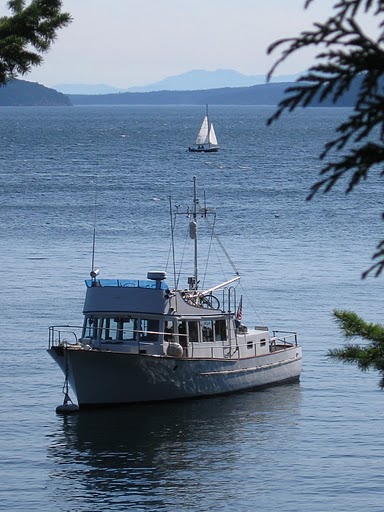Over this past week I have taken the ProSine 2.0 apart looking for any obvious signs of trauma and nothing jumped out at me.
Overall, this unit looked like a clean design and seemed well put together. Separated into a High Voltage side and Low Voltage Side the system consists of 4 major components The bottom board handles the FETs and high current stuff, two upright boards (HV and LV control board) each with a PIC micro controller and related logic to control things, and an AC relay contained inside the black box..
I would say the air flow though it is a bit hampered - all the exhaust had to squeeze under the black box on the right. Cardboard air flow control added to airflow resistance and as such I am not surprised it overheated when trying to supply more then 80A of charging current.
I did however notice that it used a lot of what I could consider questionable connector technology for a marine environment, ala:
 |
| Example of PCB connector |
The connects used appear to be tin-plated. Going back to my history in PC manufacturing, we would NEVER have used non-gold plated connectors in such an application. Seeing these I had hope that this was perhaps a major cause of the failure, and simply cleaning them and re-seating the boards (thereby doing a whipping action on the connectors) would bring it back.
 |
| Example of cables |
Hoping nothing overall was wrong and these connectors were a major weakness I disassembled the unit, cleaned everything and put it back together. Alas there was no joy.
I noted in the diagnostic screens the system would display their firmware number, except for the High Voltage Board. So I pulled it again, and re-seated the CPU in its socket. Still no luck.
 |
| HV Board |
At this point I am giving up. Xantrex provides NO support for their products to the end consumer, nor their dealer network. Parts are not available, and in short - if anything goes wrong the only choice is to round-file it. (This started coming to light about a year after I had purchased the unit.) Even if I did dig more into it it would become a hobby for me. So, to Ebay as Parts Only goes this unit, and a new Magnum MS-2000 had been order I also looked at Outback units. Both of which have a good rep these days. Not a chance I will ever purchase another Xantrex offering, based on their current support policies alone...
And of you want some interesting reading, here is one persons behind-the-scenes look at what happened over the years: http://www.hardysolar.com/inverter/inverter-history.html


No comments:
Post a Comment
Note: Only a member of this blog may post a comment.